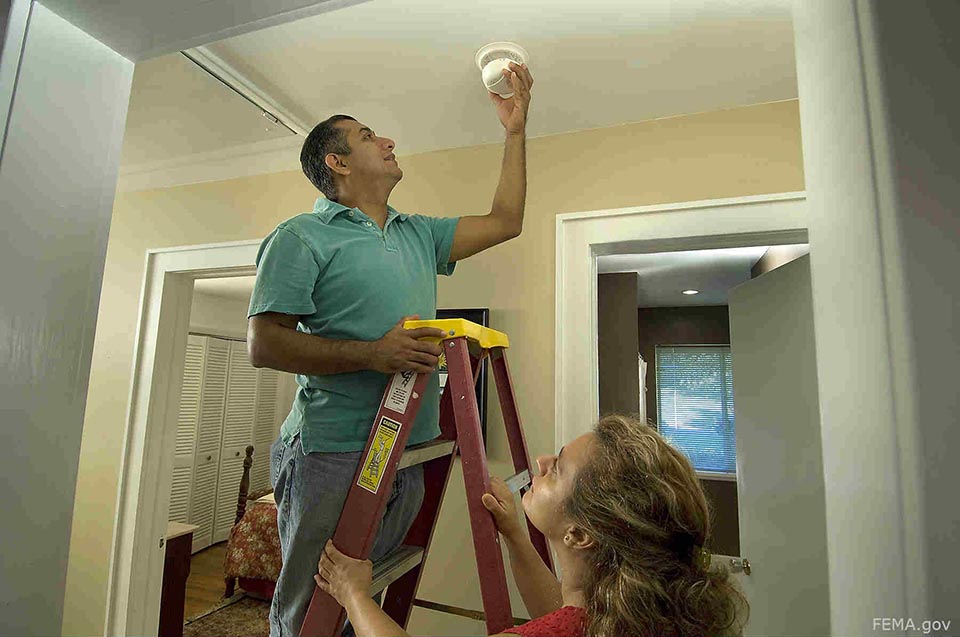Smoke detectors are part of the first line of defense your home has against a
house fire. Making sure they operate properly and are well-maintained is an important part of
fire safety in your home. Read on for more information about repairing or replacing the smoke detectors in your home.

After installation
Once place your smoke detectors in all the proper areas of your home, continue to check them each week (for about a month) after installation regardless of the alarm being hard wired or battery operated. Make sure that they are loud enough to be heard when testing, and be sure to test at different times of the day and even at night to ensure it will wake you up if you're asleep.
Replacing the smoke detector
Did you know it's recommended to replace your home's smoke detector after 10 years? When replacing your smoke alarm, you should also consider upgrading the unit to a
combination smoke and carbon monoxide detector. If you've recently moved into a new home, ask the previous homeowner when the smoke alarms were installed or have them replaced before moving in.
If your smoke detector is powered by a nine-volt (9V) battery:
- Test the alarm monthly
- Replace the batteries at least once every year
- Replace the entire smoke alarm every 10 years
If your smoke detector is powered by a 10-year lithium (long-life) battery:
- Test the alarm monthly
- Replace the entire smoke alarm according to the manufacturer's instructions since you cannot (and should not) replace the battery
If your smoke detector is hardwired into your home's electrical system:
- Test the alarm monthly
- Replace the backup battery at least once every year
- Replace the entire smoke alarm every 10 years
To replace a hardwired detector, follow these steps:
- Make sure that power is cut off to that circuit.
- Once the power is cut off to the smoke detector, remove the detector from its base/mounting plate which should be attached to the wall or ceiling.
- Once you remove the detector from the base, unscrew the mounting plate to expose the electrical box containing the wires.
- You should be able to see the wiring harness and see three wires connected by a wire nut: black, white and a colored wire (the color will vary by manufacturer).
- Remove the wire nut and attach the wire nuts in the ceiling to the new alarm in the following order: BLACK to BLACK, WHITE to WHITE and lastly COLOR to COLOR. The colored wire is to connect a second alarm in a series within your home.
- Make sure the wires have a strong connection and will be able to hold the weight of the alarm with a gentle tug.
- Screw on the new mounting plate with the new smoke alarm and thread the wires through the opening.
- Plug the wires into the new alarm and screw the alarm onto the mounting plate.
- Turn the power on for that circuit and test your alarm.
Repairing your smoke detector
If your smoke detector is damaged, old or not working entirely then you should replace the entire unit. However, the most common issues with smoke detectors are with the batteries.
If your smoke alarm has a long continuous alarm:The smoke alarm has detected a combustible product and is in alarm mode. The pulsating alarm will continue until the air has cleared. If it is a false alarm it may be due to:
- A loose or improperly installed battery
- The alarm sensing chamber may be dirty
- Humidity, steam or other environmental factors
- An electrical condition may be causing power to be interrupted to the unit
- The alarm may have reached the end of its life
Consistent chirping:
- The smoke alarm's battery may need to be replaced. If it's chirping every 30 to 60 seconds for a minimum of seven days, it's likely the battery.
- The smoke alarm may be malfunctioning. The alarm will chirp and flash a red LED light.
- The alarm may have reached its end of life.
Intermittent chirping:
- A loose or improperly installed battery
- The alarm sensing chamber may be dirty
- Humidity, steam or other environmental factors
- An electrical condition may be causing power to be interrupted to the unit
- The alarm may have reached the end of its life